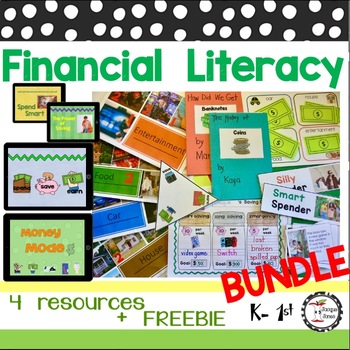Spending and Saving and Earning Money Financial Literacy Economic BUNDLE
- Zip

What educators are saying
Products in this Bundle (4)
Bonus
Description
This Primary Economic Bundle is great for introducing your kindergarteners and 1st grade students to the economic concepts of personal finance. Distinguishing between real world situations of saving and spending and earning at a young age lays a good economic foundation for your student's financial education
This Bundle has everything you need to dive into Primary Economics. Your kids will have fun while becoming familiar with all important Financial Literacy concepts. The 4 included products introduce and afford your kids just the right experiences to understand concepts of finance. The BONUS File lets them work all year with money, while they gain the experience of becoming part of a consumer economy.
BONUS FILE - MONEY MAGIC:
- Lesson Plans - Who-What-Why
- 1st-2nd-3rd-4th Quarter tips for (K-1-2)
- Fun Friday Student Store ideas
- Economics principles shown in this project based learning
- Friday Exchange procedures
- 11 student store ready to use power points
- 9 money counting templates to be used during exchange time.
I have employed this project in Kindergarten, 1st and 2nd grade (20 years total).
I think you will love it as much as I do!
Included Resources:
MONEY MODES FINANCIAL LITERACY GOOGLE SLIDES FIRST GRADE:
- Introduction to the concept of money and exchange
- Vocabulary: exchange-currency-debit-credit-heads-tails-banking
- 33 Interactive Google slides
- 5 Modes of Money: coins-bank notes-checks -bank cards-phone pay
- Each mode has 5 reading passages each answering a question:
- WHAT? - WHEN? - WHY? - HOW? - FUN FACTS
- 3 response sheets to chose from
- Report covers
- handwriting pages for informational writing
SPENDING AND SAVING:
- The Power of Saving powerpoint presentation
- Individual savings plan
- savings response sheet
- anchor chart headings
- lesson plans for saving
- Spend Smart powerpoint presentation
- Pocket Chart Header Carts
- 24 cards with real life spending situations
- individual sending plan
- Smart/Silly Spending response sheet
- lesson plans for spending
BUDGET BATTLE PROJECT:
- Round 1 directions
- Round 2 directions
- Money Budget Mat
- 8 spending brochures
- Pocket chart activity on sacrifice
- Headings "sacrifice" "for"
- Response sheet on sacrifice
- Large budget battle recording sheet, rounds 1 and 2
- small budget battle recording sheet, rounds 1 and 2
- money page for running off
- lesson plan
Save-Spend-Earn:
- Economic term definitions
- 70 interactive slides
- typical situations in kid's lives
- 3 choices each slide
- self-correcting slides
- 2 different response sheets
- student response cards
This BUNDLE has been a labor of love. I hope you find it just the thing to make your Social Studies Economics Unit sparkle!
Thanks for stopping by!
Jacque





